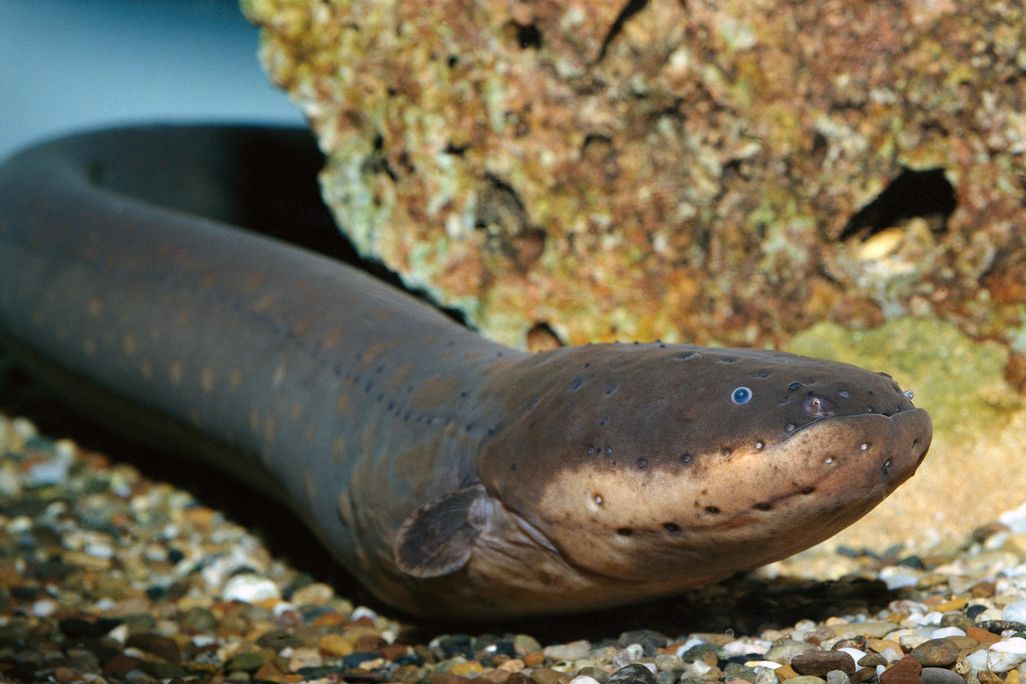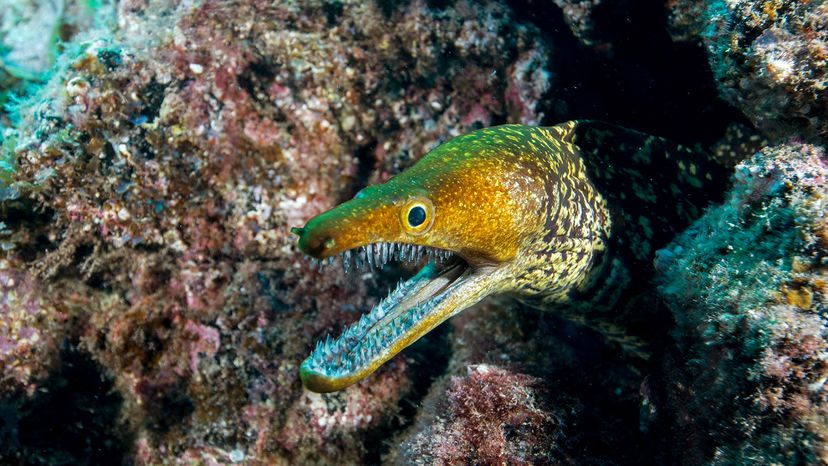Eels are long, slimy fish that look like snakes but live in water. They can be found in rivers, lakes, and oceans, and they come in many different types and sizes. Some eels are safe to eat, while others can deliver electric shocks.
Scientific Classification
-
Kingdom: Animalia
-
Phylum: Chordata
-
Class: Actinopterygii (ray-finned fishes)
-
Order: Anguilliformes
-
Families: Includes Anguillidae (freshwater eels), Muraenidae (moray eels), and others
Common Names
-
Eel
-
Electric Eel (not a true eel, but often grouped with them)
-
Freshwater Eel
-
Moray Eel
-
Snake Fish (nickname in some regions)
In some cultures, eels are a delicacy, while in others, they are seen as scary or mysterious.
Geographic Distribution
Eels live in waters all around the world, including:
-
Rivers and lakes (especially freshwater eels)
-
Coastal waters and coral reefs
-
Deep oceans (moray and deep-sea eels)
Some eels start life in the sea and move to rivers, while others stay in the ocean
Image showing Eel swimming through underwater rocks (Source: Smithsonian Magazine)
Physical Characteristics
Eels have long, slippery, flexible bodies that help them move easily through water.
-
Can grow up to 1–3 meters long, depending on species
-
Have no visible fins like regular fish
-
Smooth, often slimy skin covered with a thin layer of mucus
-
Some have small sharp teeth and large jaws
They often hide in crevices, mud, or plants, coming out at night to feed.
Species of Eels
1. Freshwater Eel (Anguilla spp.)
Image showing Freshwater eel peeking out of muddy riverbank (Source: Wikipedia)
Key Facts:
-
Found in rivers, lakes, and swamps
-
Start life in the ocean and swim upstream
-
Popular in Asian and European cooking
-
Can live for 10–20 year
2. Moray Eel (Muraenidae family)

Key Facts:
-
Lives in coral reefs and rocky coastlines
-
Known for their sharp teeth and strong jaws
-
Come in bright colors like green, yellow, and blue
-
Often mistaken for snakes
3. Electric Eel (Electrophorus electricus)
Image showing Electric eel in a tank (Source: You Tube)
Key Facts:
-
Found in the Amazon River
-
Not a true eel but related
-
Can deliver electric shocks to stun prey or defend itself
-
Lives in freshwater and breathes some air
What do eels eat?
Eels are carnivores, meaning they eat other animals. They usually hunt at night.
Their diet includes:
-
Small fish
-
Crabs and shrimp
-
Worms and insects
-
Octopuses or squid (for large ocean eels)
They use their strong jaws or suction to catch and swallow prey.
Fun facts
-
Eels can swim backward and forward easily.
-
Some eels migrate thousands of kilometers to lay their eggs.
-
Eel blood is toxic to humans unless properly cooked.
-
Electric eels can produce shocks up to 600 volts.
-
Moray eels have a second jaw inside their throat for swallowing.
Importance to Humans
Positives:
-
Eel meat is a popular food in Japan (unagi), Europe, and some African dishes
-
Eels are sold in aquariums as exotic pets
-
Electric eels are studied for medical and battery research
Negatives:
-
Some species can be dangerous or aggressive
-
Overfishing has led to a decline in wild eel populations
-
Electric shocks can harm humans or pets if not handled safely
Health & common issues
Eels are hardy but can face issues in tanks or polluted waters.
Common health problems include the following:
-
Skin infections from poor water quality
-
Parasites in the gills or stomach
-
Wounds from sharp rocks or bites
-
Stress from lack of hiding places
Care Needs (for farmed or captive eels):
-
Clean, well-oxygenated water
-
Plenty of space to swim and hide
-
Proper nutrition and temperature
-
Quarantine new arrivals before mixing
Conservation Status
Many eels are threatened by overfishing, dams, and pollution.
-
The European Eel is Critically Endangered
-
Other species like the Japanese and American eels are also in decline
-
Moray eels are mostly stable but affected by reef destruction
Conservation Actions:
-
Eel farming and hatcheries
-
Protected river and reef zones
-
Bans on young eel export in some regions
-
River ladders to help them migrate upstream
Eel vs Snake
| Feature | Eel | Snake |
|---|---|---|
| Habitat | Water | Land or water |
| Breathing | Gills (or both) | Lungs only |
| Skin | Slimy, smooth | Dry, scaly |
| Movement | Swims | Slithers on ground |
| Diet | Fish, crabs, etc. | Rodents, frogs, etc. |

Image showing Eel hiding in a coral reef, watching with bright eyes (Source: StockCake)
In case you need help with exotic fish, aquatic animal care, or aquarium health checks, you can contact Doctor Hulk Veterinary Hospital Today @ 08143397614.
















Reviews
There are no reviews yet.